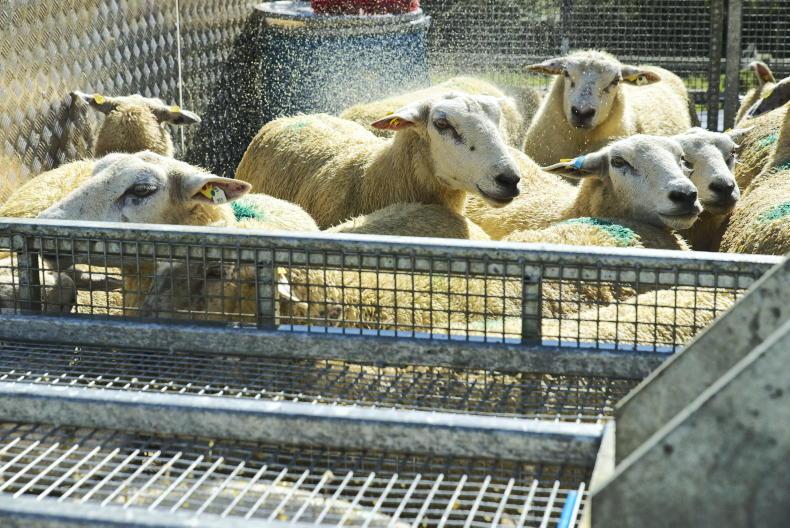The sustainable use of sheep-dipping products was one of the main topics of discussion at a recent animal health farm walk organised by Quinn’s Chemist, Crossmolina, Co Mayo. Representatives from Bimeda Animal Health addressed the subject at the walk held on the farm of Damian and John Forde, Laherdane, Co Mayo.
Rachel Mallett, veterinary specialist with Bimeda, honed in on the importance of using the correct concentration.
She explained to the farmers in attendance that chemical compounds, such as organophosphate, bind to the wool grease in the sheep as they pass through the bath.
“We start off with a set concentration in that bath, with each sheep passing through it removing some of the product. It’s important to follow the instructions to top-up the bath as required, to ensure we don’t run the bath concentration lower than the minimum effective concentration. Doing so would risk the treatment being completely ineffective.’’

Both Rachel and Shane Jennings, also from Bimeda, highlighted the need for sheep to spend a full minute in the bath for maximum efficacy.
“At 30 seconds in the tub, we only have about 50% efficacy, while at 40 seconds we are only at about 70%. Sheep need a full minute in the tub, starting from when the last sheep goes into it,” commented Shane.
Rachel had pointed to the need to fully submerge the head of sheep in the tub at least once earlier in the evening, owing to the mites associated with scab, which are able to survive in the ear canals of sheep.
Rachel also stated that there are currently no products available on the market that are licensed for use with a shower system, and that incorrect dipping procedure or the use of sheep showers run the risk of mites, which cause sheep scab, to become resistant to dip products.
PPE clothing
The type of PPE used is vital to prevent chemical contact.
“One thing that causes confusion is the specific PPE that you require for dipping. Your breathable waterproof coats and trousers – because they’re breathable, they actually have the potential to let dip chemicals through. It’s got to be the PVC or nitrile waterproofs (for dipping),’’ stated Rachel.
‘’For some products, there is a dispensing kit available to ensure you do not come into direct contact with the material, so I can’t encourage you strongly enough to use one of those dispensing kits.’’
Safe disposal of spent sheep-dip
There has also been greater scrutiny in recent years concerning water quality and chemical pollutants, such as pesticides.
From a sheep-dipping perspective, there are two main pesticides of concern – cypermethrin (non-organophosphate) and organophosphate compounds.
The chemical compounds that kill external parasites also pose a significant risk to water ecosystems, as they kill the macroinvertebrate population (aquatic insects) that fish feed on.
The source that automatically comes to mind is sheep-dip, disposed of in an incorrect manner. But contamination can occur from freshly dipped sheep passing through watercourses or dipping taking place in unsuitable weather and rain washing chemicals from the fleece of freshly dipped sheep.
With regard to disposal, it is advisable when making up the solution to wash any caps, foils and containers once they are empty. This will reduce the volume of liquid to be disposed of post-dipping.
Spent sheep-dip or spent footbathing solution should never be disposed of to a soak pit, or applied on lands without the appropriate dilution in slurry or water.

The advice for spent sheep-dip, as outlined by the Department of Agriculture and published by the HPRA, is to dilute it at a ratio of 1:3 with slurry or water, and to land spread at a rate not exceeding 5,000 litres/ha (440 gallons per acre) of spent dip, equivalent to 20,000 litres/ha (1760 gallons per acre) of diluted dip.
It is important to note that all precautions relating to the spreading of animal manures are also applicable, including adherence to prohibited application dates and adherence to buffer zones.
There are strict regulations in Northern Ireland concerning the discharge of spent dip onto agricultural lands.
Authorisation is required for most farms for the discharge of “hazardous substances and non-hazardous pollutants” onto lands from the Northern Ireland Environment Agency (NIEA).
This includes the disposal of spent sheep-dip (including cosmetic dips and shampoo) and waste pesticides (including tank washings not sprayed back over the target crop).
The authorisation typically includes the following;
